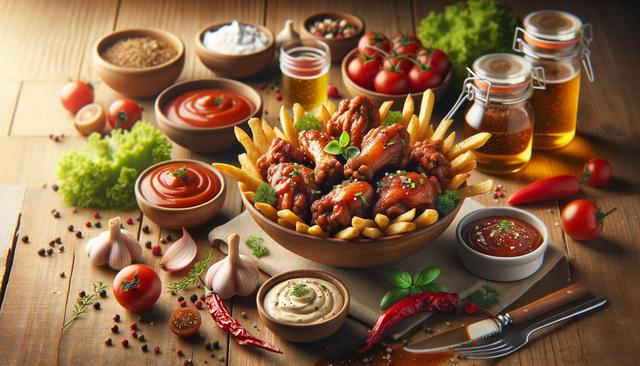The Origins Behind the Taste
Buffalo wings have a fascinating history that traces back to a small bar in Buffalo, New York, but their flavor journey goes much further. While the traditional version is often associated with a tangy, buttery sauce made with hot pepper and melted butter, this is just the tip of the iceberg. Over time, chefs and home cooks alike have experimented with seasoning blends, sauces, and preparation methods that enhance and deepen the flavor profile of these popular wings. These variations have given rise to what we might call the “hidden flavors” of buffalo wings—subtle but important notes that can transform a simple snack into a complex culinary experience.
The foundation of any great buffalo wing lies in its marinade and cooking technique. Whether baked, fried, or grilled, wings can take on distinct tastes depending on how they are handled before the sauce is even applied. Some techniques include dry brining with salt and spices, or soaking the wings in buttermilk to tenderize the meat and add a mild tang. All of these base-layer choices influence how the final flavors are perceived once the wings are sauced.
Umami Boosters and Savory Surprises
What separates a good buffalo wing from a truly flavorful one often lies in the addition of umami-rich ingredients. These components deepen the flavor without overpowering the familiar heat and tang of the classic sauce. Some kitchens add a small splash of Worcestershire sauce, soy sauce, or even fish sauce to the hot wing mixture. While each of these ingredients is used sparingly, their contribution cannot be overstated—they bring a sense of richness and depth that lingers on the palate.
Other savory additions that subtly enhance flavor include:
- Roasted garlic or garlic powder for a mellow pungency
- Smoked paprika for a touch of smokiness
- Onion powder for a slight sweetness and savoriness
These elements are rarely the stars of the show, but they play a crucial supporting role, helping to round out the wings’ flavor profile and making each bite more complex and satisfying.
Sweet, Sour, and Everything in Between
In addition to heat and saltiness, buffalo wings often contain hidden notes of sweetness and acidity that balance the bold flavors. A small amount of honey, brown sugar, or molasses can soften the sharpness of the hot sauce and add a caramelized finish. This is especially effective when the wings are grilled or broiled, allowing the sugars to develop a slightly crispy coating.
Acidity can come from more than just vinegar. Some chefs use citrus juice, such as lemon or lime, or incorporate fermented ingredients like pickled jalapeños to add a layered tang. These acidic components brighten the flavor, making the wings feel lighter and more nuanced despite being coated in a rich sauce.
Additional balancing ingredients may include:
- Apple cider vinegar for a fruity tang
- Mustard for a sharp kick
- Tomato paste for a subtle sweetness and body
These ingredients work together to create a more rounded taste that appeals to a wider range of palates.
Heat with a Purpose
While buffalo wings are known for their spiciness, not all heat is created equal. The type of chili or pepper sauce used can drastically change the experience. Cayenne is traditional, but other varieties such as chipotle, habanero, or even Korean gochujang can add complexity and distinctive regional flair.
Spice can also be layered by combining different types of heat. For example:
- Fresh chilies for a bright, immediate punch
- Dried chili powders for a smoky, lingering heat
- Fermented chili pastes for depth and funk
The balance of heat should complement, not dominate. When done right, the spiciness enhances the other hidden flavors without overwhelming the tongue. This thoughtful layering ensures that each bite delivers a range of sensations, from the initial zing to the slow-building warmth that follows.
Unexpected Pairings and Dipping Sauces
Finally, the accompaniments served with buffalo wings can either enhance or dull their intricate flavors. Traditional sides like celery sticks and carrot slices offer a refreshing contrast, but the real magic often lies in the dipping sauces. While ranch and blue cheese dressings are common choices, there are many lesser-known options that bring out the hidden flavors of the wings.
Some alternative dipping sauces that accentuate flavor include:
- Yogurt-based sauces with herbs and lemon zest
- Peanut or sesame dips for a nutty counterpoint
- Avocado crema for a cooling, creamy texture
These sauces not only complement the wings but also add new dimensions of flavor. Pairing wings with craft beverages, like hoppy beers or dry ciders, can also elevate the overall tasting experience, helping to highlight the hidden notes within the spice and sauce.
Conclusion: Savoring the Layers
Buffalo wings are often celebrated for their spicy kick, but there’s far more happening in each bite than meets the eye—or palate. From umami-packed ingredients to sweet and tangy enhancements, the hidden flavors of buffalo wings are what make them a continually evolving favorite for food lovers. For those who enjoy exploring new tastes and culinary techniques, paying attention to these subtle elements can turn a familiar snack into a memorable eating experience. Whether you’re cooking at home or ordering from your favorite kitchen, keep an eye (and taste bud) out for those secret ingredients that make buffalo wings truly special.


